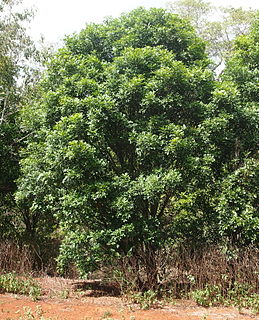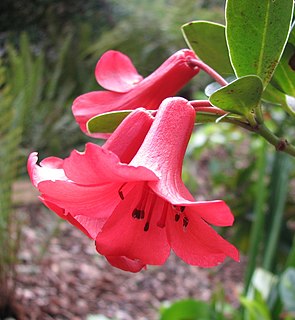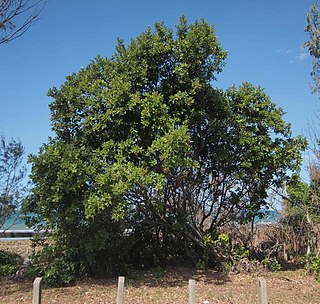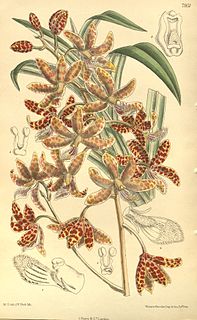
Acacia harpophylla, commonly known as brigalow, brigalow spearwood or orkor is an endemic tree of Australia. The Indigenous Australian group the Gamilaraay peoples know the tree as Barranbaa or Burrii. It is found in central and coastal Queensland to northern New South Wales. It can reach up to 25 m (82 ft) tall and forms extensive open-forest communities on clay soils.

Brachychiton rupestris, commonly known as the narrow-leaved bottle tree or Queensland bottle tree, is a tree in the family Malvaceae native to Queensland, Australia. Discovered and described by Sir Thomas Mitchell and John Lindley in 1848, it gained its name from its bulbous trunk, which can be up to 3.5 metres (11 ft) diameter at breast height (DBH). Reaching 10–25 metres (33–82 ft) high, the Queensland bottle tree is deciduous, losing its leaves between September and December. The leaves are simple or divided, with one or more narrow leaf blades up to 11 centimetres (4 in) long and 2 centimetres (0.8 in) wide. Cream-coloured flowers appear from September to November, and are followed by woody boat-shaped follicles that ripen from November to May. No subspecies are recognised.

Banksia proteoides, commonly known as king dryandra, is a shrub endemic to Western Australia. It was known as Dryandra proteoides until 2007, when all Dryandra species were transferred to Banksia by Austin Mast and Kevin Thiele.

Atalaya is a genus of eighteen species of trees and shrubs of the plant family Sapindaceae. As of 2013 fourteen species grow naturally in Australia and in neighbouring New Guinea only one endemic species is known to science. Three species are known growing naturally in southern Africa, including two species endemic to South Africa and one species in South Africa, Swaziland and Mozambique.

Grevillea flexuosa, commonly known as zigzag grevillea or tangled grevillea, is an endangered shrub endemic to Western Australia.

Rhododendron lochiae is a species of plant in the family Ericaceae, and is one of only two species of the genus Rhododendron that are native to Australia. It is found only in restricted areas of mountain–top cloud forest habitats within the Wet Tropics of Queensland World Heritage Site. The other species, Rhododendron viriosum, was only formally classified as a separate species in 2002.

Stirlingia simplex is a plant endemic to Western Australia.

Calytrix is a genus of shrubs in the family Myrtaceae described as a genus in 1806. They are commonly known as starflowers. Calytrix are endemic to Australia, occurring in the.

Xanthostemon chrysanthus, commonly named Golden Penda, also popularly known as First Love, is a species of tree in the myrtle family Myrtaceae, endemic to north eastern Queensland.

Maclura cochinchinensis, commonly known as cockspur thorn, is a species of vine or scrambling shrub in the family Moraceae. The native range extends from China, through Malesia and into Queensland and northern New South Wales. The species inhabits various types of tropical forest: most commonly in monsoon forests. The globular, yellow or orange fruit are sweet and edible and were a traditional food source for Australian Aborigines.

Litsea bindoniana, known as the big-leaved bollywood is a rainforest tree in the laurel family. A small to medium-sized bushy tree endemic to the rainforests of tropical Queensland, Australia. It features large leaves with attractive yellow venation, 25 cm (10 in) long by 10 cm (4 in) wide. They are dark green above, and paler and somewhat hairy below. The leaf stalks are hairy. The small greenish flowers are fragrant and occur from March to May. They are followed by fruits which mature from September to October, being a black drupe. Regeneration is from fresh seed, after removing the fleshy aril around the seed.

Syzygium fullagarii, commonly known as the scalybark, is a relatively large tree in the Myrtle family. It is found only on Lord Howe Island. It grows to 20 metres tall, up to an altitude of 400 metres above sea level in sheltered areas, often in rainforest. The bark is reddish brown, usually flaking to the touch. The base of the tree is often heavily buttressed. Known for many years as Cleistocalyx fullagarii, however, in recent times it has been placed in the large genus Syzygium.

Exocarpos latifolius is a species of parasitic tree, in the plant family Santalaceae. They have the common names broad leaved ballart, scrub sandal-wood, scrub cherry, oringorin, broad leaved cherry or native cherry. The species is found in monsoon forest, littoral rainforest and occasionally in more open forest types in Malesia and across Northern Australia.

Ehretia saligna, commonly known as peach bush, native willow and peachwood is a species of shrubs or small trees, endemic to Northern Australia. The natural range extends from the Gascoyne, across the Northern Territory throughout northern Queensland and coastal; regions of Southern Queensland and New South Wales.
Wendlandia psychotrioides is a species of shrubs or small trees, constituting part of the plant family Rubiaceae.
Hollandaea is a small genus of plants in the family Proteaceae containing four species of Australian rainforest trees. All four species are endemic to restricted areas of the Wet Tropics of northeast Queensland.
Maytenus bilocularis, commonly known as orangebark, is a tree that is endemic to eastern Australia. It grows to 10 metres high and has leaves with toothed edges that are 3 to 9 cm long and 1.3 to 3 cm wide and elliptic, ovate or obovate in shape.

Blepharocarya involucrigera is a tree in the sumac family Anacardiaceae. It is endemic to Queensland, Australia. Common names include north Queensland bollygum, northern bollygum and rose butternut.

Alectryon connatus, sometimes named hairy alectryon, is a species of small trees, constituting part of the plant family Sapindaceae.

Dipodium pictum, commonly known as brittle climbing-orchid or climbing hyacinth-orchid, is an orchid species that is native to Malesia and the Cape York Peninsula in Australia.


















